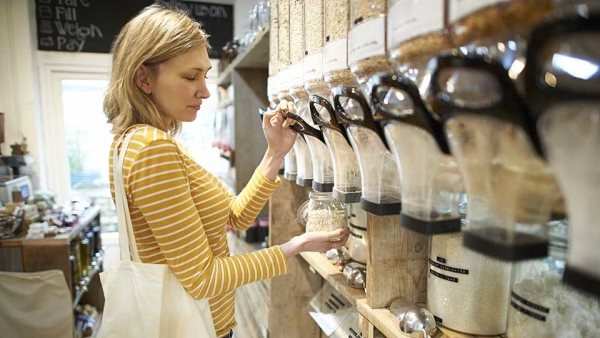The truth about superfoods
Are they just another marketing ploy or something more?


High fat, low fat, sugar-free, probiotic-rich and salt-reduced – we’ve all been bombarded with fancy supermarket packaging at some point.
But, what about superfoods? Are they just another marketing ploy, or something more?
We chatted with The Body Doctor Dietitian Dr Naras Lapsys and Newcastle University Nutrition and Dietetics Professor Clare Collins to find out whether superfoods are really that – well – super.
What are superfoods?
The term ‘superfood’ was arguably first used by the United Fruit Company to market the humble banana during WWI. Today, you’ll generally hear superfood thrown around when the word is describing more exotic (or expensive) fruits, vegetables, oils and seeds.
Here’s where it gets murky, though – what truly defines a superfood is often very different from the way marketers use it on that fancy packaging.
According to Naras, true superfoods are whole, unprocessed fruits, vegetables, meat and seeds that when eaten in moderation and with variety, offer a host of health benefits.
“All unprocessed foods are superfoods and bring interesting nutrients to the table. If you’re eating soluble and insoluble fibres, an abundance of vegetables (preferably with the skin on), actual pieces of fruit and a variety of protein sources, you are eating a diet high in legitimate superfoods.”
But, what about those trendy ‘superfoods’ that are splashed across TV screens and social media feeds – like acai, goji and kombucha?
“Acai definitely has health benefits,” says Naras. “However, it is no more than any other nutrient fruit. The problem with these kinds of foods though, is how we eat them. Acai on its own is great, but they are made into smoothie bowls with processed granola, served in higher than recommended serving sizes with honey and added sugars. With all the additives, it’s no longer optimal for your health.”
Naras explains that any nutrient-rich food you have in your shopping trolley, from leafy greens (rich in vitamins A, C, E and K, iron and calcium) to omega-3 laden salmon, nuts (for their protein and monounsaturated fats) and fibre-rich wholegrains are classified as superfoods.
Vegetables and fruits are the real superfoods.
Clare, who’s the brains behind nib foundation program No Money No Time agrees, “Vegetables and fruits are the real superfoods. The benefit of them comes in the variety of each whole food category, and it certainly doesn’t need to break the bank.”
How does a food become a ‘superfood’?
It’s all down to the product’s marketing team, because although there are plenty of nutrient-dense foods that are technically superfoods (hello, broccoli), the term is often only used when a marketing agency decides it’ll help sell a product.
Back in the 1940s, a muffin brand decided to label its products as superfoods (claiming that one of their muffins was ‘a superfood that contained all the known vitamins and some that had not been discovered’). It wasn’t until the 90s that the term evolved to start describing things like pomegranate, wild Maine blueberries and Amazon-sourced acai berries.
There isn’t a universal definition or regulation on what can be labelled a superfood (however, Europe does legally require products to explain on their packaging why they claim the term), so it’s best to use your own discretion and the Australian Dietary Guidelines to guide you on what you eat.

Superfoods – mighty or myth?
According to Naras, it depends on what you’re calling a superfood and why. “A single ingredient can not be the focus of your entire diet. If you eat an acai bowl in the morning, that doesn’t mean you’ve consumed your day’s recommended nutrients,” he says. “If we must call foods ‘superfoods’ then it should be about consuming unprocessed, whole vegetables, fruits, nuts and legumes; eating a wide variety of these foods and all in healthy moderation.”
Clare agrees, “Most Australians aren’t going to be able to consistently afford to buy hyped-up marketed ‘superfoods’ and they’re going to get far greater benefit from eating a wide range of fruit and vegetables from their local farmers’ market or supermarket. Fill your diet with as many whole vegetables and fruits as you can within your budget and you’re doing far more for your health than spending $30 on a handful of the latest marketed superfood.”
| Superfood | Key nutrients | Cheaper alternative |
|---|---|---|
| Kale | Calcium, iron, magnesium, vitamin A, vitamin B6, fibre | Broccoli |
| Chia seeds | Calcium, iron, zinc and magnesium, protein | Sesame seeds |
| Goji berries or acai berries | Vitamin A, antioxidants | Raspberries |
| Quinoa | Fibre, protein | Lentils |
| Wheatgrass | Iron, calcium and chlorophyll | Spinach |
| Coconut water | Electrolytes and hydration | Water (tap or bottled) and a banana |
What’s the best way to get nutrients out of our food?
Naras believes consuming unprocessed foods in their entirety brings out the greatest amount of nutrients.
“Keeping the skin on your fruit and vegetables (when it’s edible) is great for getting the most fibre and nutrients out of your unprocessed whole foods,” he says. “It’s also important to find your protein and fibres from a variety of different sources. If you can afford it, include legumes, nuts and seeds in your protein consumption.”
Clare’s advice is to mix up as many different fruits and vegetables into your diet as possible.
“Buy and cook your dinner with variety in mind. Consume a wide range of whole foods and cook them in a variety of different ways. This will not only ensure you are consuming every nutrient these foods have to offer, but it will also keep you interested in eating them.”
Need some healthy meal ideas that make the most out of some serious ‘superfoods’? We’ve partnered with a range of nutritionists and dietitians to create a suite of delicious recipes, Check out our recipes page for more.
Everything you need to know about high protein food
Learn about the benefits of high protein foods, with expert dietician tips for different dietary preferences and goals.
What is the difference between kilojoules and calories?
Are calories and kilojoules the same thing?
A little junk food is fine, right?
We look at why junk food is bad for our health




